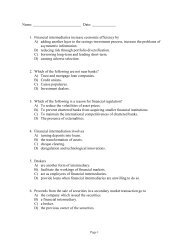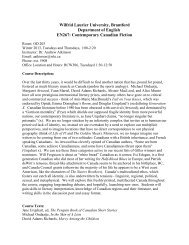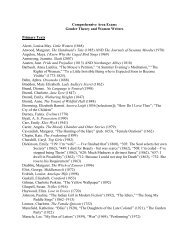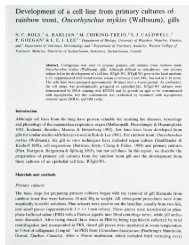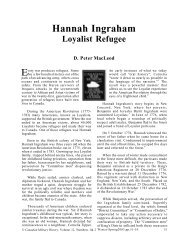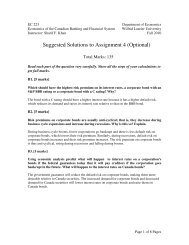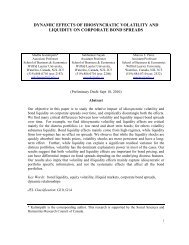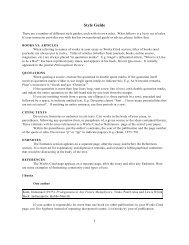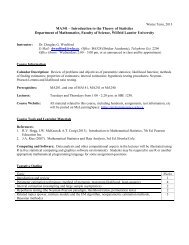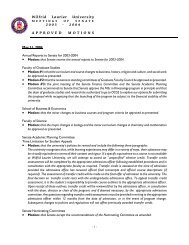Taxonomy of the Polygonum douglasii (Polygonaceae ... - WLU
Taxonomy of the Polygonum douglasii (Polygonaceae ... - WLU
Taxonomy of the Polygonum douglasii (Polygonaceae ... - WLU
You also want an ePaper? Increase the reach of your titles
YUMPU automatically turns print PDFs into web optimized ePapers that Google loves.
12 BRITTONIA<br />
[VOL. 57<br />
Key to <strong>the</strong> <strong>Polygonum</strong> <strong>douglasii</strong> complex<br />
1. Pedicels patent or erect.<br />
2. Leaves with one pleat on each side <strong>of</strong> <strong>the</strong> midvein --------------------------------------------------------------------------------- P. tenue<br />
2. Leaves not pleated.<br />
3. Ocreae 1–4 mm long, funnelform; perianth 1.8–2.5 mm long; achenes 1.8–2.3 mm long.<br />
4. Plants 1.5–3.5 cm tall; leaves and bracts uniformly papillose, cylindrical due to revolute margins<br />
that join toge<strong>the</strong>r on <strong>the</strong> abaxial face ---------------------------------------------------------------------------------------- P. utahense<br />
4. Plants 3–50 cm tall; leaves and bracts glabrous or papillose only on <strong>the</strong> margins; leaves plane<br />
or with narrow revolute margins, which are never joined toge<strong>the</strong>r on <strong>the</strong> abaxial face.<br />
5. Plants glabrous; flowers wide-open ------------------------------------------------------------------------------------ P. cascadense<br />
5. Plants papillose-scaberulous at least on <strong>the</strong> ocreae; flowers closed or semiopen.<br />
6. Leaves elliptic, obovate to subround, pure green adaxially, margins plane or narrowly<br />
revolute, irregularly thickened or denticulate-papillose; an<strong>the</strong>rs 120–165 �m long ----<br />
-------------------------------------------------------------------------------------------------------------------------------------------- P. minimum<br />
6. Leaves linear to narrow elliptic, � glaucescent adaxially, margins revolute, smooth;<br />
an<strong>the</strong>rs 250–325 �m long ---------------------------------------------------------------------------------------------- P. nuttallii<br />
3. Ocreae 4–12 mm long, not funnelform; perianth 3–5 mm long; achenes 2.5–5 mm long.<br />
7. Inflorescence dense, cymes crowded and overlapping at stem and branch apices; an<strong>the</strong>rs<br />
400–550 �m long ---------------------------------------------------------------------------------------------------- P. spergulariiforme<br />
7. Inflorescence open, cymes regularly spaced along stem and branches; an<strong>the</strong>rs 130–200 �m<br />
long ----------------------------------------------------------------------------------------------------------------------------------- P. sawatchense<br />
8. Stems and ocreae glabrous; leaf blades linear to linear-lanceolate, smooth on <strong>the</strong> margins.<br />
-------------------------------------------------------------------------------------------------- P. sawatchense subsp. sawatchense<br />
8. Stems and ocreae scaberulous-papillose; leaf blades elliptic or elliptic-lanceolate, denticulate-papillose<br />
on <strong>the</strong> margins --------------------------------------------- P. sawatchense subsp. oblivium<br />
1. Pedicels reflexed.<br />
9. Ocreae 6–12 mm long; flowers and achenes 3–5 mm long.<br />
10. Flowers wide-open or semiopen; pedicels 0.5–1 mm long; perianth tube 9–17% <strong>of</strong> <strong>the</strong><br />
perianth length; an<strong>the</strong>rs 400–550 �m long -------------------------------------------------------------------------- P. majus<br />
10. Flowers mostly closed; pedicels 2–6 mm long; perianth tube 20–28% <strong>of</strong> <strong>the</strong> perianth length;<br />
an<strong>the</strong>rs 125–150 �m long ------------------------------------------------------------------------------------------------- P. <strong>douglasii</strong><br />
9. Ocreae 3–5 mm long; flowers and achenes 2–3 mm long.<br />
11. Inflorescence dense, cymes overlapping at stem and branch apices; flowers wide-open, with<br />
<strong>the</strong> tube 10–15% <strong>of</strong> <strong>the</strong> perianth length; an<strong>the</strong>rs 325–380 �m long ------------------------ P. gabrielae<br />
11. Inflorescence elongated, spike-like, cymes spaced along stem and branches; flowers closed,<br />
with <strong>the</strong> tube 25–33% <strong>of</strong> <strong>the</strong> perianth length; an<strong>the</strong>rs 100–160 �m long.<br />
12. Tip <strong>of</strong> mature achene exserted from perianth; lower leaves linear-oblanceolate with<br />
smooth margins ---------------------------------------------------------------------------------------------------- P. engelmannii<br />
12. Tip <strong>of</strong> mature fruit enclosed in perianth; lower leaves broadly elliptic to ovate, with<br />
margins minutely denticulate-papillose ----------------------------------------------------------------- P. austiniae<br />
1. POLYGONUM TENUE Michx., Fl. Bor.<br />
Amer. 1: 238. 1803. TYPE: CANADA.<br />
‘‘Herbier de l’Amérique septentrionale.<br />
In Canada, at Mona Caesarea ad Snake<br />
Bill,’’ Michaux s.n. (LECTOTYPE, here designated:<br />
P, specimens on left side <strong>of</strong><br />
sheet).<br />
<strong>Polygonum</strong> tenue var. protrusum Fernald, Rhodora<br />
44: 393. 1942. TYPE: United States. Virginia.<br />
Southhampton Co.: Blackwater River, SE <strong>of</strong> Ivor,<br />
16 Oct 1941, Fernald & Long 13937 (HOLOTYPE:<br />
GH; isotypes: NY, US).<br />
Annual herbs. Stems 5–50 cm long, 4–<br />
angled, green or brownish, erect, simple or<br />
branched, with a few to many branches, upper<br />
edges glabrous, � winged or denticulate-papillose;<br />
papillae on <strong>the</strong> edges (when<br />
present) conical, 80–120 �m, papillae on<br />
<strong>the</strong> stem faces spherical, 7–18 �m, located<br />
at <strong>the</strong> same level with <strong>the</strong> epidermis cells<br />
(Fig. 1A). Leaves: basal leaves caducous or<br />
persistent at flowering; upper leaves reduced<br />
to scale-like bracts upward; ocreae<br />
6–15 mm, glabrous, free part soon disintegrating<br />
into a few brown fibers; blades narrowly<br />
lanceolate to linear, with 2 deep<br />
pleats parallel to <strong>the</strong> midvein, 25–40 � 1–<br />
8 mm, margins usually plane, denticulatepapillose,<br />
apex mucronate or cuspidate. Papillae<br />
on leaf margins conic-elongated or<br />
cylindrical, 110–200 �m. Inflorescences<br />
terminal, spike-like, slender and elongated;<br />
cymes 1 or 2(3)-flowered, widely spaced<br />
along stem and branches; bracts shorter to<br />
equaling <strong>the</strong> flowers <strong>the</strong>y subtend. Flowers<br />
closed; pedicels erect, 1–1.5 mm; perianth



